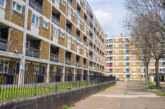 Matthew Warburton, Policy Advisor at the Association of Retained Council Housing (ARCH), discusses the impact of the pandemic on local authorities.
Matthew Warburton, Policy Advisor at the Association of Retained Council Housing (ARCH), discusses the impact of the pandemic on local authorities.
Provided roll-out of the vaccination programme permits a return to near-normal working and social interaction by the summer, the British economy is expected to grow by around 4% by the end of the year, according to the Office for Budget Responsibility. This forecast, issued with the Budget on 3rd March, is good news, but implies that the economy is not expected to return to its pre-COVID level before the summer of 2022. It remains uncertain how much permanent ‘scarring’ the pandemic will inflict and how far our ways of working, shopping and socialising will be changed forever.
Local government has been profoundly affected. The National Audit Office reports that councils forecast that COVID-19 has created £6.9bn of additional cost pressures in 2020-21, together with a reduction in non-tax income of £2.8bn; together these represent 17.6% of revenue expenditure.
Impacts vary across authorities, with district councils being most exposed to loss of income, while counties and unitary authorities under greatest cost pressures because of their social care responsibilities. Some authorities are at risk of financial failure. Up to February 2021, MHCLG had provided exceptional financial support to four, with two further councils — Croydon and Nottingham — where action is likely. The NAO estimates that around 20 councils remain at high risk of failure.
Not surprisingly, councils’ housing services have been among those affected. HouseMark data suggest that there has been a 30% increase in rent arrears over the last 12 months, together with a 50% increase in the number of void properties, which will also impact significantly on council HRA income. There has also been significant growth in the backlog of non-emergency repairs, which will require concerted action once a return to near-normal working is possible.
Variation among councils
COVID has forced major changes in the way councils interact with their tenants, with a major increase in digital transactions. Interestingly, this may have made communication with their landlord easier for some tenants, and there is some evidence that tenant satisfaction has improved over the last year despite the curtailment of some services.
However, these generalisations conceal wide variation among councils. Some report no increase in arrears or voids, and repairs backlogs appear to vary too. Although all social landlords have been working to the same MHCLG guidance throughout the pandemic, it is clear that councils have interpreted it differently in adjusting their ways of working, with more and less successful results. Sickness absence has risen in all councils, but the impact on service delivery seems also to have been very variable.
The year ahead poses councils multiple challenges. Most face difficult decisions over where and how to cut service spending, while at the same time service pressures are growing, whether backlogs of work that could not be completed during lockdown, or higher service demand as a result of COVID-driven problems including unemployment or reduced income. Virtually all are planning to use reserves to shore up spending, which risks simply postponing the pain until next year.
In parallel, however, there are crucial choices to be made about how services are delivered in a post-pandemic (or possibly a permanent-pandemic) world; how far, in other words, should the new normal resemble the old? What has been learnt from having to rely for a year largely on digital communication and staff working from home? Alongside these service challenges, last year’s Social Housing White Paper proposes a more demanding regulatory regime to raise standards across the sector. If councils’ experiences have been as diverse as the data suggest, there is an urgent need for a better understanding of what has driven these differences and to draw out and share the lessons to help all council landlords plot a route to better performance.









